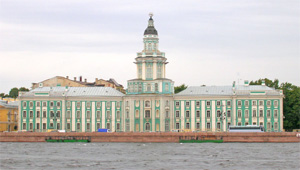 Museum of Anthropology and Ethnography
Museum of Anthropology and EthnographyUNIVERSITY Embankment from the Spit to Mendeleyevskaya Liniya was probably designed by Thomas de Thomon and faced in granite in 1805-10 under the direction of the engineer Gerard and the businessman Sukhanov, who was given the contract for the work. The last section - as far as the Academy of Arts was improved later, in 1831- 34. All the buildings on the embankment date from the 18th century and four of them are remarkable examples of the Petrine Baroque style - the Kunstkammer (1718-34), the Twelve Collegia building (1722-42), the palace of Peter II (1710s-27) and, finally, the Menshikov Palace.
The Kunstkammer
The first Russian museum, founded by Peter I, was formed in accordance with a programme drawn up by the great German scholar Gottfried Leibniz (1646-1716). The collections that Peter had already assembled by that time were systematized and formed the basis for the museum display. The building, which became known by the German name Kunstkammer (Kunstkamera in Russian) or The Chamber of Curiosities, was begun in 1718 and completed in 1734. The original design was the work of Georg Mattarnovy (perhaps in collaboration with Andreas Schliiter), but it was modified during construction by Harbel. Chiaveri and Zemtsov. who supervised the work over the years. The central section of the building with a tower topped by a dome was intended for an anatomical theatre and Russia's first observatory. It also housed the Gottorp Globe (1664. Germany) with a diameter of more than 3 metres. The globe was a gift to Peter the Greai in connection with the betrothal of Duke Charles Frederick of Holstein-Gottorp to his eldest daughter, Anna.
Porcelain sake bottle Tokkur. Korean art exhibit. Bronze statuette of Prince Rama - the hero of the Thai epic "Ramakiana". Thailand. Thais







